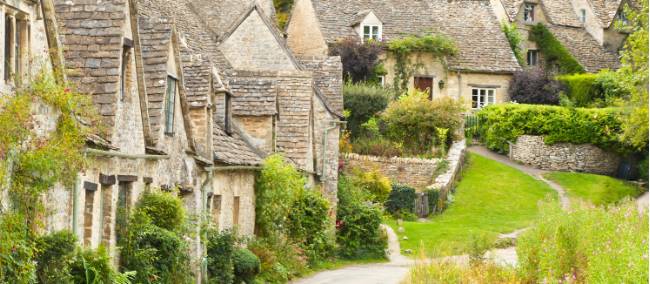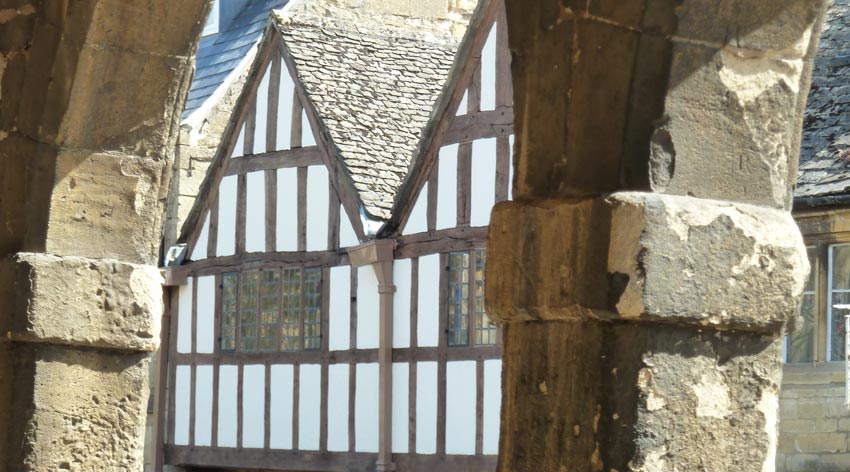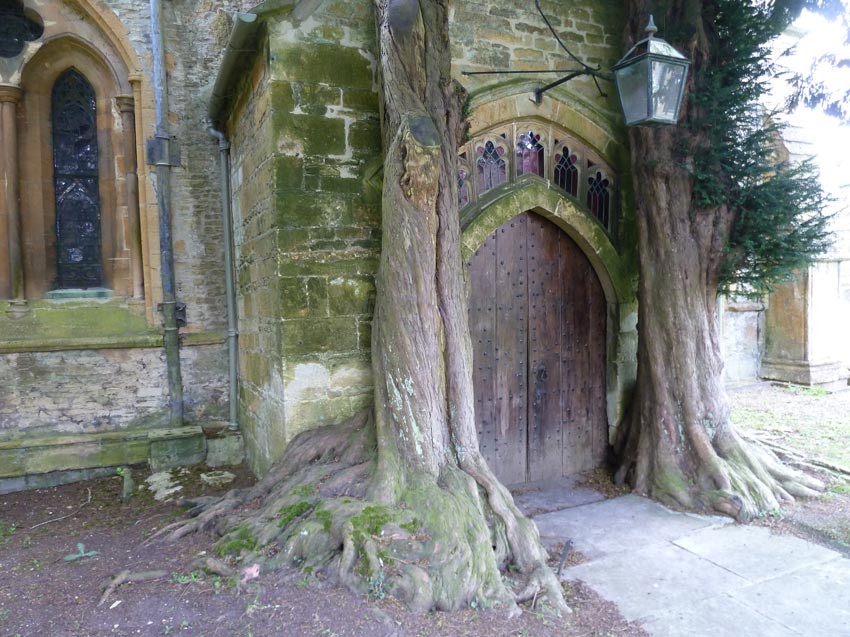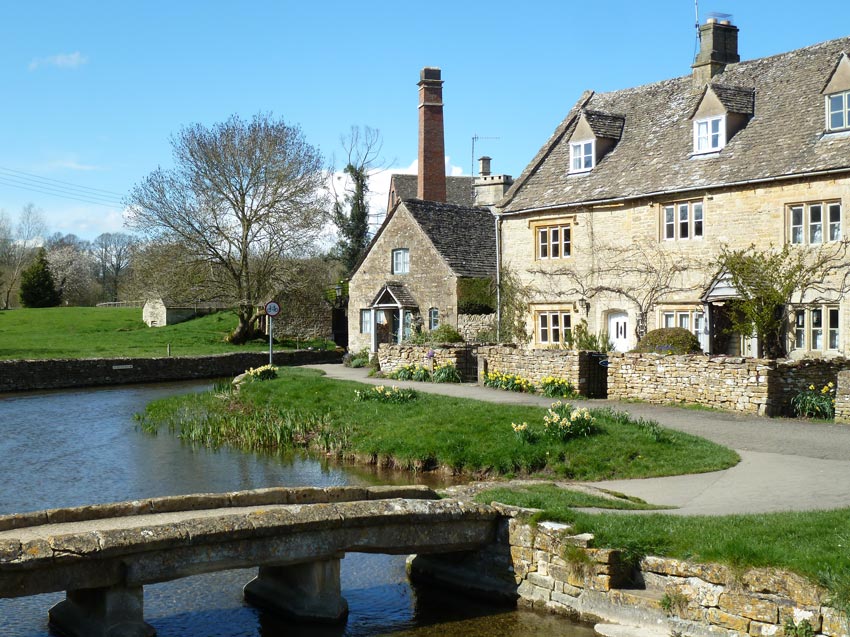
The charming village of Bilbury in the Cotswolds
Blog home / Tips and Advice on Walking in the Cotswolds
Walking in the Cotswolds
The Cotswolds is a region of fine walks and quintessentially English countryside. Along with an introduction to walking in the Cotswolds, this article contains some great tips from the Walkers' Britain resident guide, John Millen, to help you get the most out of your visit.
Introduction to the Cotswolds
The Cotswolds conjures up a vision of honey coloured stone walls, green rolling fields and pretty villages, and yet the human component of the landscape is largely derived from the Enclosure Acts 1700-1840 which partitioned the fields here with the famed dry stone walls. The name ‘Cotswolds’ comes from the word for the stone sheep shelters or ‘cots’ and ‘wolds’ mean hills. Most of the towns precede the regions namesake enclosures and are charming places to visit. Highlights on our walks in the Cotswolds include places with extraordinary names and old world features; such as Chipping Campden, Bourton on the Water, Lower Slaughter, Moreton in the Marsh, Stow on the Wold and Stratford upon Avon. The lovely stone that is characteristic of the Cotswolds was held in such high regard that it was sent far afield to build St. Paul's in London, many of the Oxford colleges and even the Melbourne Cathedral in Australia.
The Cotswold Way
The Cotswold Way is a 100 mile route from Bath, along the Cotswolds escarpment, to the market town of Chipping Campden. Our Cotswold walking holidays do not walk the official Cotswold Way but cross over it on some of the days. Our trips instead have been designed to follow more localised paths to take in the more interesting villages in the Cotswolds itself, such as Bourton on the Water, which the Cotswold Way does not visit. Our route also gives clients the opportunity to visit places such as Hidcote Manor & Gardens.

Our Favourite Towns in the Cotswolds
Here are the highlights of a few of our favourite towns and villages that you can visit on a walking holiday in the Cotswolds.
Chipping Campden
Famous for its High Street filled with beautiful honey-coloured stone buildings, it’s often described as the most perfect High Street in England. Anyone searching for the heritage of the Middle Ages, will find it here, as in the space of a hundred metres or so you’ll find excellent examples of Elizabethan, Georgian, Jacobean, Regency and Victorian architecture.
Attractions include the church of St James, a landmark for miles around, to the north of the town. It is a magnificent example of an early perpendicular wool church (churches built on the proceeds of the wool trade, which was prospering at the time), rebuilt in the 15th century. Next to the church are the lodges and the gateway to the old Campden House, built by Sir Baptist Hicks in the 17th century and burnt down during the Civil War. The long, broad and curved terraced Chipping Campden High Street contains many superb Cotswold stone buildings built by wealthy merchants between the 14th and 17th centuries.

Broadway
This is often referred to as the ‘Jewel of the Cotswolds’ and the ‘Show Village of England’ because of its sheer beauty. The ‘broad way’ leads from the foot of the western Cotswold escarpment with a wide grass-fringed street lined with honey coloured limestone buildings dating back to the 16th century. The village became a busy staging post on the route from Worcester to London as coaches had to harness extra horses for the long pull up Fish Hill. Back then as many as 40 inns existed within the village to service the many travellers passing through.

Guiting Power
This village is run by a self-administering self-help housing trust that has preserved the village in its beautiful present state because it has restricted building and also been instrumental in keeping people born in the area in rented housing. These are ancient manorial lands and archaeologists assume that there are the remains of a Roman Villa under the manor house foundations. The church of St. Michael's has a well preserved Norman doorway with an hourglass motif. In the field next to the church you can see the mound of a Bronze age burial, as well as the foundations and alter of the original Saxon church, which you could perhaps get 12 people in.

Blockley
During the 18th century when the wool industry was in decline Blockley turned to silk production. By 1884 six silk mills powered by the fast-flowing Blockley brook provided work for about 600 people preparing silk for ribbon-making factories in Coventry. The village is a unique collection of buildings reflecting its past glory of mills and silk production and is quite different in, character to other north Cotswold villages.

Stow on the Wold
A pretty market town and has a memorial Stone to the Battle of Stow 1646 during the English Civil War. Stow stands exposed on a 700 feet high hill at a junction of seven major roads, including the Roman Fosse Way. At the height of the Cotswold wool industry the town was famous for its huge annual fairs where as many as 20,000 sheep were sold at one time. Around the village’s vast market square the visitor is faced with an elegant array of Cotswold townhouses.

Lower Slaughter
The name of this quaint village stems from the old English name for a wet land or ‘slough’ upon which it lies beside the little Eye stream and is known for its unspoilt limestone cottages in the traditional Cotswold style. The stream running through the village is crossed by two small bridges and the local attraction is a converted mill with original water wheel selling craft type products. There is the Low Scarp Manor that has a bar and does afternoon teas and of course the inn.

Bourton-on-the-Water
Some call this (optimistically perhaps) the ‘Venice of the Cotswolds,’ but it is one of the showplaces of the region, attracting visitors again and again with its special charm with its expanded river, tiny bridges and glassy waters The oldest town houses date back to the 17th century. But if its cottages are of no great antiquity, the village can trace its story from pre-Roman times, when there was a military camp here at Salmonsbury. A number of ancient trackways converged on Bourton. The most important of these was - and still is - the Roman Fosse Way, which starts from the mouth of the Humber and ends in Devon.

Our Tips for Walking in the Cotswolds
We asked our resident walking guide, John Millen to give us his top tips for walking in the Cotswolds:
- A plastic cleaning brush for your boots can be useful as after the rain the trails in places become sticky clay.
- The Cotswolds can be surprisingly cold , always carry warm clothes even in good weather.
- Make full use of the wonderful pubs for reasonably priced evening meals etc.
- National Trust members bring your membership cards to visit some of the attractive gardens such as Hidcote.
- In Stratford Upon Avon (worth an extra day) you can get multiple entry tickets to visit places such as Anne Hathaway’s cottage.
- Binoculars are always handy, bird varieties seem to be improving especially the Red Kite which is now quite a common sight.
- Drop into some of the gorgeous churches, St. Edwards in Stow on the Wold is one of my favourites and is famous for its hobbit style door between two yew trees.
- Climb the Broadway tower in good weather for the views and a cup of tea in the café on the top.

Find all Walking and Cycling Holidays in the Cotswolds